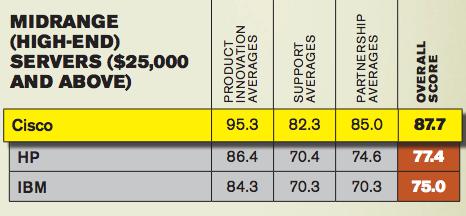…here are the type of votes contestants would love to receive. We recently saw two items that speak well on the progress of UCS against the most important yardsticks: how IT professionals and our partners rate Cisco as a computing systems vendor.
First up is CRN’s Annual Report Card. This is where IT solution providers rate vendors in categories of product innovation, support and partnership. For Midrange Servers, Cisco took top marks:
Note the margin. A blowout worthy of Dickie V superlatives. We have CRN’s commentary on the Midrange category posted here and you can doubleclick into a detailed scores breakout on their Report Cards page.
Next up: TheInfoPro Servers and Virtualization Study. This is a recurring report from 451 Research, now in it’s 12th iteration, which brings together interview feedback from IT professionals. You have to love a good old 2×2 (especially the upper right.) Here, customers located Cisco in the lead among server vendors on both the Promise and Fulfillment indices:
Report highlights:
- Cisco tops the charts in both promise and fulfillment among large and midsize enterprises, significantly leading HP, IBM, and Dell.
- Cisco ranks highest of all vendors in strategic vision and technical innovation.
- Cisco’s rating is extremely positive, above average in 13 out of 14 categories.
- Cisco is the ONLY server vendor to be ranked in the leading quadrant in 2010, 2011, and 2012 of the TheInfoPro study.
Now, please re-read that list, but this time out loud and in your best Dick Vitale voice. You have to throw in a few “BAAAAYBY”s to achieve the full effect. ‘Tis the Season, after all.
Keep an eye out during the tournament this year, you might just see a TV spot about a Cinderella story….




CONNECT WITH US